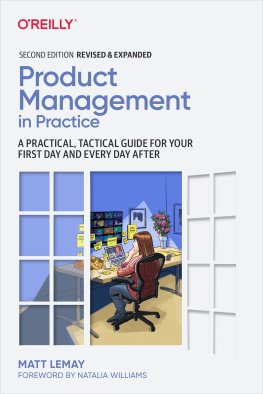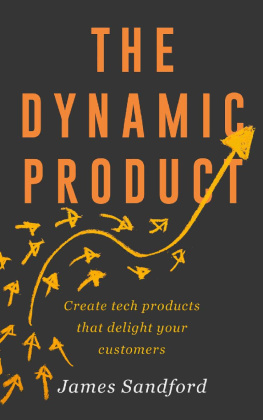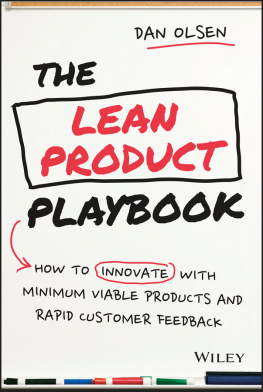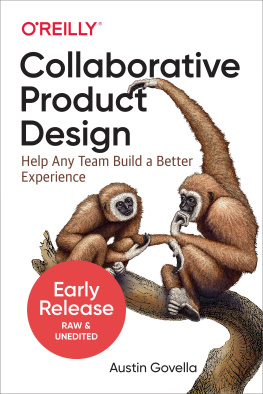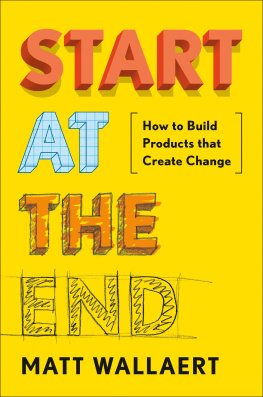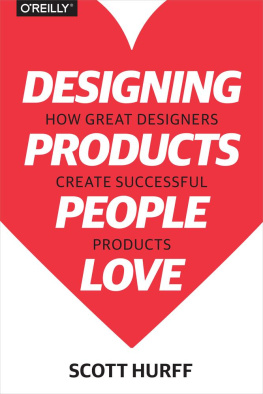All rights reserved.
To my wonderful wife, Stacey, who keeps me sane; our kids who keep me curious; all the wonderful people who work at Nine Labs, who keep me motivated; and last but not least, all the clients weve had the pleasure of working with, who keep us learning.
Introduction
Follow the path of the unsafe, independent thinker. Expose your ideas to the danger of controversy. Speak your mind and fear less the label of crackpot than the stigma of conformity.
Thomas J. Watson, former CEO and Chairman, IBM
Have you ever had a brilliant idea? Maybe you thought of an app that would make your life easier. Maybe you thought of a way to improve something you already use. Maybe you work in a big company, and youre just trying to make things better. Most people have had these types of ideas. What happens next?
Did you try to build it? Did you build a company around it? My guess is you started working on that idea in your minds eye and got stuck somewhere along the way. Dont beat yourself up. That happens a lot.
People get stuck because they dont have a simple framework for building things people love. Building things is hard and messy. Lots of people think its a linear process, with one step after another. After all, thats how we go through life, one step at a time.
Building great products is a messy and convoluted process that can feel confusing until you see the patterns that help make sense of it all. This book is intended to do just thatmake sense of the chaos. Over the last twenty - five years, Ive seen patterns that can increase the clarity and confidence you need to build great products.
I call these patterns Loops. More on that later.
A Quick Story
When I was six years old, my mom gave me a remote - controlled G.I. Joe tank for Christmas. We were poor, and she probably spent a whole weeks pay on it. It was the coolest thing Id ever seen. After a few minutes of proudly driving it around the living roomcrashing over the discarded wrapping paper, bows, and boxesI got curious about what made the turret turn and how the tracks worked. So I went back to my bedroom and took the whole thing apart.
Sometime later, Mom found me like a skilled mechanic disassembling an engine. Id laid out all the parts of this tank in nice, neat rows and groups. Every screw and tiny part arranged and accounted for. I was thrilled. She was not. Here I was, this little kid with his new toy all in pieces across the bedroom floor. Needless to say, she chastised me for breaking something shed spent a lot of money on. I told her it would be okay, but she wasnt buying it. Then an hour or so later, I drove the fully functional tank back into the living room and explained how it worked to my astonished mother.
Ive always been curious about how things work. Im constantly thinking about the mechanics behind peoples motivations, about the incentives and disincentives in the systems that drive behavior. When I look at great business models, I ask myself what makes them work. When businesses fail, I want to know why.
When I started my first business out of high school, I was that six - year - old boy disassembling a tank again. I was in over my head, and it took lots of effort to figure out how things worked. But I did it anyway. Over the last twenty - five years, Ive taken things apart and put them back together again many times. Ive grown five companies and built literally hundreds of software products, systems, platforms, and services. Now Im taking what Ive learned and driving the tank back into the living room. But instead of my mom, this time Im explaining how it works to you.
So, You Want to Make Something Great?
You probably picked this book up hoping to get practical tips and tricks to help you make better products and services. The good news? Those tips and tricks are in here. The bad news? Creating something of real value takes changing how you think about what youre making and who youre making it for. It also takes a lot of work. Its messy, challenging, rewarding, complicated, and surprisingly simple at the same time. Lots of people either overthink things and make it too complex, or take shortcuts when things get hard and miss crucial steps. This book should help you strike a balance and learn how to do things right with the appropriate amount of effort.
Creating a product or service people love is hard work, but the reward of seeing people use (and pay for) the thing you made is completely worth it. Whether youre building something new or breathing new life into something that already exists, the concepts, exercises, and activities in this book will help you create something great.
First, lets reset the way you think about products.
The New Economy
In the dark ages before the Internet, we lived in a seller - driven economy . People were only aware of what was at their local market, so they had limited choices. People relied on advertising and word of mouth to learn about new products and services. Companies would create new products based on not much more than a Don Draper - esque hunch and a few focus groups, then blast them into the world with very little targeting by todays standards. Companies could succeed through the sheer brute force of mass marketing and advertising. If Gillette made a new razor, people who need razors would likely buy it because of how often they saw it advertised and how few competing products there were on shelves.
In this seller - driven economy, reaching a mass market was really only possible for large companies like Unilever, Procter & Gamble, and Coca - Cola that could spend millions on national advertising campaigns. Today, some startup down the street can make a Google ad in five minutes that can reach a huge (and highly targeted) audience for a fraction of that cost. And thats not even counting all the ways to reach people on social media. Just look at how rapidly Dollar Shave Club has grown, gobbling up Gillettes market share with a fraction of their advertising budget. Now you see Gillette offering razor subscriptions to compete with the little guy. This wouldnt have been possible without the power of the Internet.
The Internet has given consumers access to nearly any product, anywhere in the world, at any time. This access to the long tail of products and services has shifted the landscape and created a buyer - driven economy . People now have access to niche products which satisfy their specific wants and needs. As this trend continues and more options become available to buyers, sellers face increased pressure to create products that people will not only buy and use but actually love.
The good news is the Internet has also given companies access to previously invisible groups of customers. The long tail goes both ways.
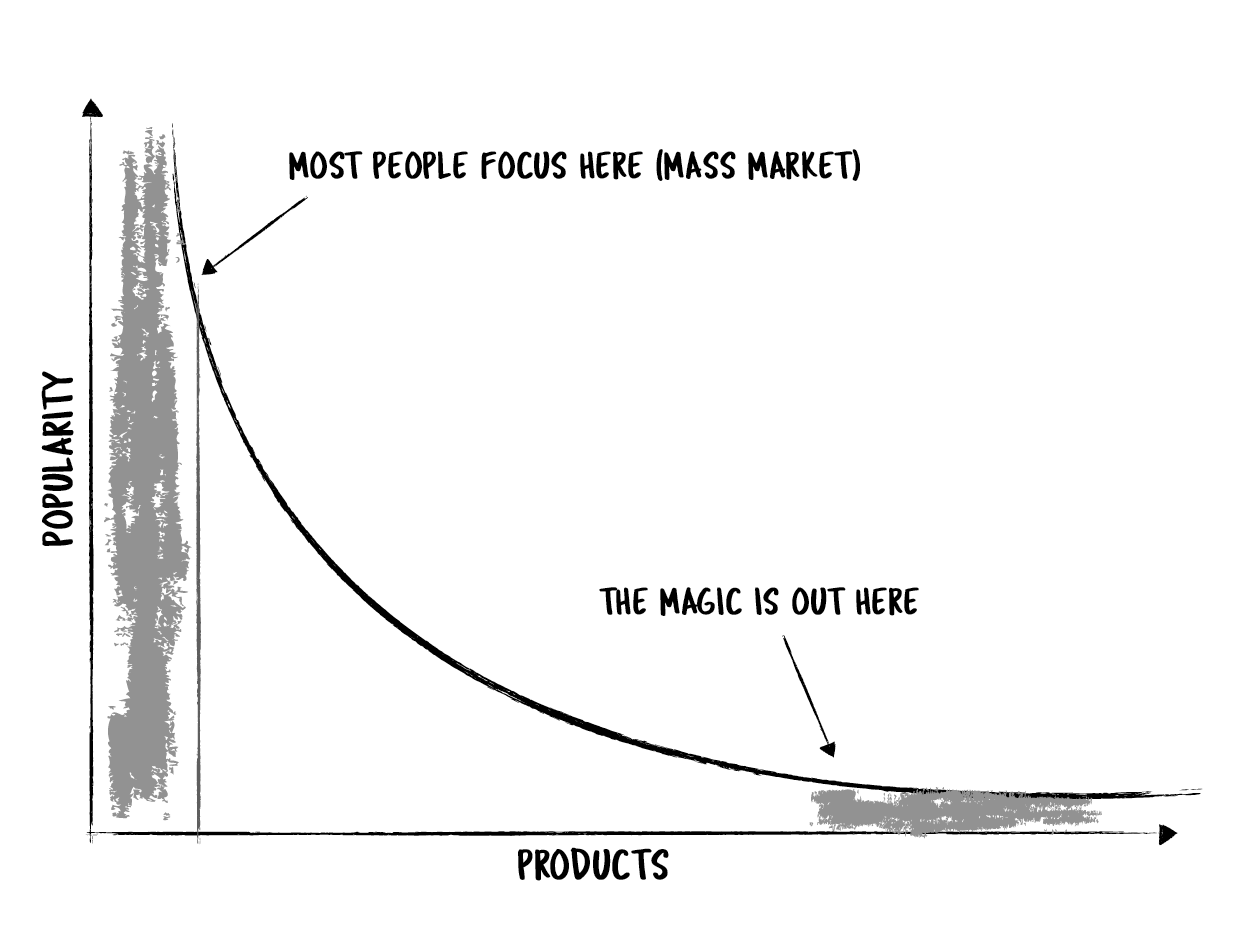
The challenge is no longer finding and reaching your customersits understanding them. What are their needs and wants, pains and fears? To build a successful business, you must intimately understand your customers because they are the ones driving todays economy forward. Dont be afraid to get really specific about who your target customer is. With the tools and techniques youll learn in the following pages, coupled with the power of modern advertising and social media platforms, youll be able to describe who they are, find them, and build things for them with amazing results. As we like to say, there are riches in the niches.




